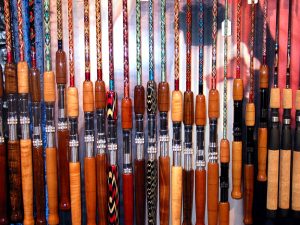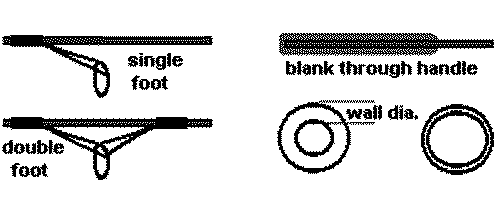Welcome to Signaturefishingrods.com
Welcome to the “Fishing Rod Elements” page of Signaturefishingrods. com. This contains an explanation of the fishing rod components and the basic information needed when buying a rod. If you do not need an explanation, then click on the “Home” page and see the many custom fishing rods offered by Signaturefishingrods. com.

Custom Fishing Rods by Grandt
The industry’s innovative custom fishing rod builder.
Understanding Why These are The Best Fishing Rods, Custom Fishing Rods
A Primer On Fishing Rods
Fishing rods come in a large variety of styles and lengths, each designed for specific uses to meet a particular situation. Among the components that make up a fishing rod are a rod blank, handle, reel seat and guides. These components determine the amount of vibration that travels from the lure/bait up through the line to the hand. The more vibrations a rod transmits, the more sensitive it is. The greater the sensitivity, the more you will understand what is going on in the water.
Fishing Rod Components
Components that make up a fishing rod arerod blank, handle, reel seat, guides and ferrules if used.
All components determine the amount of vibration that travels from the lure/bait up through the line to the hand. The more vibrations a rod transmits, the more sensitive the fishing rod. The greater the sensitivity, the more you will understand what is going on in the water.
The impact of the ferrules is dependent upon the number and the type used in a given fishing. The fewer ferrules results in a more sensitive fishing rod. The type of material in a ferrule also impacts the sensitivity. Graphite ferrules are more sensitive than metal ferrules.
Fishing Rod Blank
The rod shaft is called a blank and generally, it is made using graphite. Fiberglass or other materials can be used by themselves or in combination with graphite. Most rods today are made of graphite due to their strength, lighter weight and greater sensitivity. The thickness and density of the blank material also influences the characteristic of a fishing rod. Graphite is more sensitive than fiberglass.
A high quality graphite blank is the key to better fishing rods. The number of modulus of graphite is a measure of resistance to flex. The higher the modulus of the graphite, the stiffer and stronger the blank. Higher modulus graphite rods also can be more brittle. Higher strength allows the need for less material in the graphite blank. Less material means less weight and less mass for the vibrations that are being generated to travel through thereby increasing the sensitivity of fishing rods.
Graphite blanks can be made with the graphite strain running lengthwise or crosswise. There is typically more strength and sensitivity in a blank that has graphite running lengthwise.
Characteristics of a Fishing Rod Blank
The characteristics of a fishing rod blank are determined by what portion of the fishing rod flexes and how much strength it takes to make the rod flex. The technical definition of “action” refers to where or how much of the rod will bend. A fast action rod will start to bend more toward the tip whereas a slow action rod will tend to bend over the entire length of the shaft. A medium action rod will start to bend in the middle.
The taper of the a blank also impacts the action. A rod with a fast taper will only flex the top portion of the rod. Medium fast and medium tapers will flex approximately 30 to 60 percent of the rod respectively. If the rod has a slow taper, almost the entire rod or blank will bend or flex under pressure.
Rod taper is important for several reasons. The feel for the lure being used and the fish being caught impact the appropriate taper use. For example, a fast action tip can be used when fishing jig type lures. The angler can feel and therefore control what the lure is doing quite easily. Since only the very tip of the fishing rod bends, when a fish strikes the angler has ample power and backbone to set the hook correctly.
In contrast to fast tapers, the slow flex rods offer the angler advantages when fighting large fish with light line. This additional flex allows the fishing rod to absorb the force of the fish as opposed to the line.
Taper is where you get your hook setting power (backbone) in the fishing rod. A fast action tip has the hook setting power more toward the tip of the rod while a moderate tip is toward the middle.
Power or strength is the amount of force needed to flex the fishing rod. This is determined by the thickness and type of fishing blank material. Most fishing rods in sports shops when marked are referring to power (lite, medium, heavy, etc.) and not action. The power of a rod should be consistent with the line weight ratings.
Rod Action Diagram


- Transmit line vibrations to the fishing rod so it is easier to “feel” the fish.
- Distribute stress applied to the blank while fighting a fish.
The real seat is another important factor. How the reel is attached to the fishing rod is critical. You do not want the reel to come loose or fall off. A superior fishing rod should incorporate reel seats that keep the reel firmly attached to the rod. Graphite is an excellent material used in reel seats. My preference is a collar that is tightened by hand to attach the fishing reel. Others prefer to use slip rings, tape or a screw locking devise.
While most fishing rods incorporate graphite or plastic reel seats that serve the general purpose of keeping the reel firmly attached to the rod, different reel seats are designed to handle a range of fishing reel foots. It is possible to buy a fishing reel that does not properly fit a reel seat of a fishing rod.
Graphite blanks that go through-the-handle increases sensitivity. Check to see if fishing rod blanks run through the handle, providing the extra sensitivity needed for fishing success.
The type and length of a handle in a fishing rod is important to consider before you purchase a rod. The length of a handle should match the type of fishing you plan to do. Flicking a topwater bait requires flexibility in the wrist. A shorter handle such as a trigger handle is appropriate.
When using crankbaits, and other lures, the pulling of the line requires more power than topwater fishing. The length of the handle is generally more comfortable if it touches a spot between your wrist and elbow when held in your hand at the reel. When fishing heavy cover such as weeds, heavy action rods are used to set the hook and get the fish out of the heavy cover. In this case, to get the leverage you need, a handle should probably reach your elbow.
Also, the material of the handle, whether cork or foam should be considered. Will wet hands slip off potentially causing the fishing rod to drop into the water? Several experts say cork handles offer the most sensitivity for detecting nibbling or soft-biting fish. They also have greater aesthetic appeal. However, cork handles can occasionally break. There are many types of handles, each designed for an individual’s comfort and personal preference.
Still not convinced that a sensitive fishing rod is the key to catching more fish? Try this simple test. Tie a piece of approximately 15 inches of 6 or 8 lb. fishing line loosely to the top guide of a rod. Hold the fishing pole as if you were on the water. Have someone flicked his/her finger against the line. If you can feel the vibration in your hand, then the rod has reasonable sensitivity.
If you could not feel the vibration, have the other person hold the line (i.e. put some tension on it) and flick it again. You should have no problem feeling the vibration when tension is put on it. This simulates a harder hit. The problem: if you did not feel any vibration without someone holding the line, you will not feel the lighter hits. Light hits are encountered frequently. A custom fishing rod from Signaturefishingrods.com will let you feel the vibration of light hits!
Question or Comment
Have a question or comment? Email Jeff by clicking the “Question” button on the upper right.



